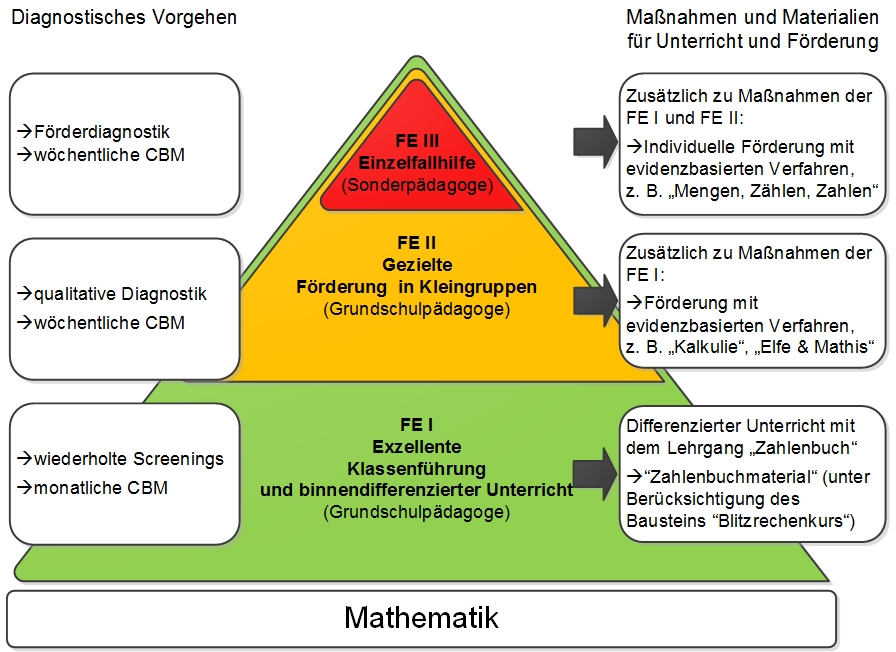Mathematics - Summary
In the RIM framework we mainly use methods and materials in math classes that fulfill scientific criteria and that prove to be useful for gaining arithmetical competences (evidence-based practice). In this way, high-quality education and support can be guaranteed that reach as many students in a class as possible. The Number Book (Wittmann & Müller, 2004) fulfills all the required quality criteria and demands as it contains a broad variety of additional materials which makes it suitable for both underachieving as well as top-performing students.
Those school children, who do not respond to the educational measures as desired, can be identified in regular screenings and curriculum-based measurements (CBM) that capture each learning progress. With the help of the mathematics navigation system (MathNav) the current stage of learning is being analyzed and possible reasons for learning difficulties can be detected. Then, further educational measures are planned and conducted on up to three prevention levels. The higher the level of prevention is, the more CBM are conducted to assess the learning progress (once a week maximum), and the evaluation will be more detailed. If the further performance is not successful, the interventions have to be modified. In this case, scientifically proven and evidence-based materials for additional support, such as the three-part training program Calculia (Gerlach, Fritz, Ricken & Schmidt, 2007) or the computer program Math Games with Elfe and Mathis (Lenhard & Lenhard, 2010), can be used for intensive and direct measures to help students with learning difficulties. They are tutored additionally by the elementary school teacher on the second prevention level in small learning groups. Furthermore, the special education teacher supports the children with severe disabilities individually in one-on-one sessions or in very small learning groups on the third prevention level. Thus, the concept allows an increase of genuine learning time, and the students also receive more personal attention.
The combination of these elements should help children with initial small learning deficits to prevent them from increasing and long-term problems. Students that nevertheless develop considerate deficits in mathematics are instructed with the help of differentiated and inclusive educational measures. For individual cases it has to be decided whether or not a repetition of the school year is necessary. The following figure provides an overview of procedures that aim at preventing learning disabilities in mathematics.
References
Gerlach, M., Fritz, A., Ricken, G. & Schmidt, S. (2007). Kalkulie. Trainingsprogramm Baustein 1. Berlin: Cornelsen.
Lenhard, W. & Lenhard, A. (2010). Rechenspiele mit Elfe und Mathis. Göttingen: Hogrefe.
Wittmann, E.Ch. & Müller, G.N. (2004). Das Zahlenbuch 1. Lehrerband. Stuttgart: Klett.
Krajewski, K., Nieding, G. & Schneider, W. (2007). Mengen, zählen, Zahlen. Die Welt der Mathematik verstehen. Berlin: Cornelsen.
Gerlach, M., Fritz, A., Ricken, G. & Schmidt, S. (2007). Kalkulie. Trainingsprogramm Baustein 1. Berlin: Cornelsen.

